Frederick III of Aragon, King of Sicily (1296–1337). Frederick III of Aragon was the third king of the Aragonese dynasty on the throne of Sicily. He ruled from 1296 to 1337 and he was the only Aragonese king of Sicily who made a significant use of his image. In particular, we have four official (namely, commissioned directly by him or his entourage) representations of him: the royal seal, the billon silver denaro coin, the lost mosaic from the Church of Santa Maria della Valle (known as Badiazza) near Messina, and the mosaic in the Cathedral of Messina.
- royal images
- royal iconography
- kings of Sicily
- Aragonese dynasty
- Frederick III of Aragon
1. Introduction
Notwithstanding he already ruled as vicar of his brother James II from 1291, only in 11 December 1295 was Frederick III of Aragon elected King of Sicily by the Sicilian Parliament. Afterwards, he was crowned in Palermo on 25 March 1296 and he reigned until his death in 25 June 1337 (about Frederick III of Aragon, King of Sicily, see [1–4], the update [5] and synthetically [6–8]. More recent but not particularly interesting are [9–11]. For a historiographical framework on Frederick III, see [12], [13] (pp. 183–211)). Among the kings of the Aragonese dynasty on the Sicilian throne, Frederick III seems to be the only one who made significant use of his image and, for this reason, he has been selected to represent the iconography of this royal family (we do not know of any images of Peter III of Aragon acting as King of Sicily. The lost wall paintings of the Cappella di Santa Maria Incoronata in Palermo date back to the 16th century [14] and it does not seem that he made a specific seal for the Kingdom of Sicily by only using the seal of king of Aragon [15] (Volume 1, pp. 115–117 and 207–208). With regard to James II of Aragon acting as King of Sicily, we only have the images of the seal [15] (Volume 1, p. 8 and pp. 240–241, no. 187), [16] (p. 82, although the reference should be corrected) and the denaro [17] (p. 10), [18] (p. 264 and pp. 696–697, plate 42, images no. 769–770)). Regarding him, we have four official (namely, commissioned directly by him or his entourage) representations: the royal seal, the billon silver denaro coin, the lost mosaic from the Church of Santa Maria della Valle (known as Badiazza) near Messina, and the mosaic in the Cathedral of Messina (about the identification of Frederick III’s official image, see [19]).
2. The Royal Seal
Diplomatic research attests to the use of a seal to corroborate the documents issued by Frederick III’s royal chancellery (for example, the catalogue for the exhibition on the Messina documents of the Fundación Casa Ducal de Medinaceli of Seville quotes a document from 12 July 1332 with a hanging seal (however, it was later lost) [20] (p. 183, document no. 77)) and, in a paper from 1997, Maria Grazia Fallico listed some diplomas from this king bearing a seal [21] (pp. 69–70). In particular, they were a parchment from 1320 of the Commenda della Magione section of the Archivio di Stato di Palermo (in reality, in the inventory of the archive there is only one document for 1320 and it is not from Frederick III [22] (p. 315, card no. 596). The diploma in question, instead, is no. 606 from 29 July 1329 [22] (p. 324, card no. 613). The Repertorio points out the absence of the seal (this has also been kindly verified personally by Dr. Serena Falletta, archivist at the branch of the Catena of the Archivio di Stato di Palermo)), two parchments from the city of Messina issued on 1 October 1302 and stored in the Archivio ducale Medinaceli in Toledo, and four parchments from the city of Caltagirone issued in 1299 and stored in the Museo Civico di Caltagirone, in the parchments section of the Universitas di Caltagirone.
To my knowledge, these seals have never been published; however, I was able to examine some items in Caltagirone (thanks to the kind help of archivists Margherita Dizia and Enzo Piluso). All four of the examples from this location are identical. They are red wax hanging seals placed in a wooden box (Figure 1). The legend has the inscription FRIDERICUS TERCIUS DEI GRACIA REX SICILIE DUCATUS APULIE ET PRINCIPATUS CAPUE and the image displays the king on a horse facing left. The sovereign is wearing a helmet with a crown, with a sword in his right hand and a shield in his left. Both the latter and the caparison of the horse bear the coat of arms of the dynasty: quartered with red bars in the field or of Aragon and a black eagle in the field argent of Sicily.
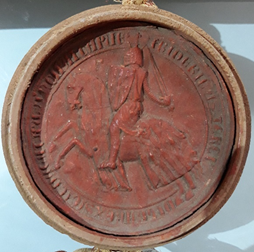
Figure 1. Seal of Frederick III of Aragon as King of Sicily, impression on red wax, 15 October 1299. Museo Civico di Caltagirone (ex Carcere Borbonico), section Pergamene della Universitas di Caltagirone, inventory number MC 4910, 10/22 1997. Photo taken by author.
Owing to the various political vicissitudes that characterized the reign of Frederick III, the royal title changed over the years (about the different royal titles of Frederick III, see [13] (pp. 191–192)). The seal probably had to adapt itself to these alterations. Nevertheless, due to the small number of items preserved, it is not possible to verify whether there were changes in the iconography or whether this type with the royal image was used for all 41 years of his reign (even if it is probable). Regardless of this, the iconography of the seal clearly differs from the specimens of the Norman and Swabian predecessors, but it perfectly follows the pattern of the Aragonese predecessor as King of Sicily. Indeed, it is identical to the seal of his brother James II, and it probably goes back to a tradition belonging to the kings of Aragon in the Iberian Peninsula (about the iconography of the Norman-Swabian kings of Sicily, see [23]. About the iconography of the kings of Aragon, see [16]).
Without doubt, this image is an official representation of Frederick III, and it mainly had a juridical function (it was used to corroborate the legal value of diplomas and documents issued by the royal chancellery). Its mobile support would have facilitated its circulation inside the Kingdom and, in this way, it could reach a large number of subjects. However, we should consider that seals were not made to move around but to be stored, with their documents, in the archives of their recipients. Moreover, their dimensions (although they were bigger than the seals of the Norman predecessors and in line with the Swabian and Aragonese tradition) (the diameter of the seals of the Norman kings varies between 25 and 35 mm. Instead, the Swabian and Aragonese seals can be as big as 95–110 mm [23] (passim), [15] (Volume 1, pp. 207–209). An example of James II of Aragon, identical to that of Frederick III from an iconographic point of view, has a diameter of 70 mm [15] (Volume 1, p. 209, n. 38)) were somewhat reduced and certainly of scarce visual impact. Finally, their use was not particularly common either. Despite the reorganization of the administration and the improvement to the royal chancellery done by Frederick III (about these aspects, see [24] (pp. VII-CCXV)), we should note that the average number of issues did not seem to be very high during his reign (about this aspect, see [25], [26] (in particular, for the recapitulatory table, p. 5)). If we also consider that the same recipients could receive several documents, we can suppose that the number of subjects involved was not particularly great and was limited at the aristocratic and ruling class of Sicilian society (moreover, note that the number of preserved diplomas is greater for the lay archives than for the ecclesiastical archives [21]. Can we argue that there were more documents for the first than for the second?). Therefore, in line with these data, it was not very frequent to be able to see the royal image of the seal and only a limited number of people would have had this opportunity.
3. The Denaro
Among the official representations of Frederick III, there is also the image of the billon silver denaro minted in Messina (Figure 2) (about this image, see [17] (p. 15 and image in plate 2, no. 36), [18] (pp. 267–268, p. 698 and plate 43, images no. 780–782)). Its function was mainly legal: It was used in order to corroborate the legal value of the coinage. On the obverse of this coin is the legend + FRI • T • DEI • GRA (namely, Fridericus tertius Dei Gratia), with the crowned head of the king turned to the left encircled in small pearls. He has long hair and, probably, a shaved face. The reverse displays the inscription + REX: SICILIE: and a cross pattée again encircled by small pearls. We do not know whether it continued to be issued during the years when the king adopted the title of Rex Trinacrie (namely, from 1311 to 1314 and from 1319 to 1320) (about the Frederick’s different royal titles, see again [13] (pp. 191–192)). However, it is plausible that it circulated for all the years of Frederick III’s rule. The iconography of this coin is really generic and stereotyped and it is difficult to say whether it was following a specific tradition. However, we can argue that Frederick III again adopted an Aragonese pattern. Indeed, the image of this coin is very similar to that of the denaro of his brother and predecessor James II (about James II’s denaro, see [17] (p. 10 and image in plate 1, no. 17), [18] (p. 696 and plate 42, images no. 769–770)).
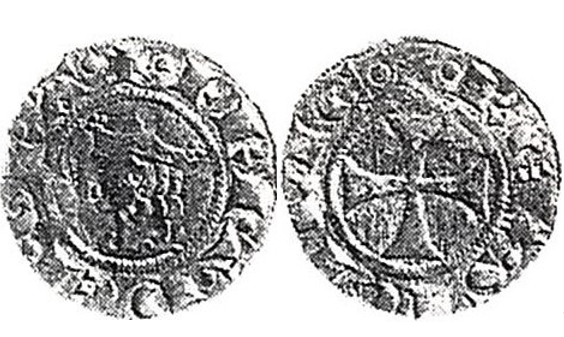
Figure 2. Denaro of Frederick III of Aragon, King of Sicily, obverse and reverse of billon silver coin, 1296–1337. Reproduced with permission of the Licensor. Image published in [18] (plate 43, image no. 780).
Certainly, on a coin, the royal image could move around the entire kingdom (that is, the island of Sicily and part of Calabria) and the lesser worth of a silver coin in comparison to a gold coin would have made its use more widespread. Moreover, we know that probably around 1315, Frederick III implemented a monetary policy to place stricter royal control on the circulation and actual quality of the currency (about that, see [11] (pp. 87–88)). In addition, he ordered an abundant amount of silver coins to be minted while at the same time limiting the minting of gold coins (about that, see [17] (p. 11), [18] (pp. 265–268 and for more general information pp. 257–260)). Considering that the former also included the denari with the king’s head (for an overview of Frederick III’s coins, see [17] (pp. 12–16), [18] (pp. 265–268, pp. 696–699 and plates 42–43, images no. 771–782)), the possibility of coming across the royal image would have been quite high. Nevertheless, coins could be hoarded and, moreover, anthropologists have noted that in general, when coins are used, more attention is placed on their economic worth than their images. Furthermore, we have to consider that this denaro did not have a particularly great visual or emotional impact: It is very small (the diameter is only 16 mm and the weight is 0.58–0.65 g) and it has a certain iconographical inaccuracy and stylization that makes it difficult to identify the subject that is represented.
4. The Mosaic of the Church of Santa Maria Della Valle in Messina
The Church of Santa Maria della Valle, also called della Scala or Badiazza, with the connected convent of Benedictine nuns (these days, the congregation is almost nil) is in Contrada Badiazza near Scala, in a mountainous area along the San Rizzo stream, approximately three miles from the center of Messina (about this church, see [27] (pp. 51–60), [28] (pp. 3–8), [29], [30] (pp. 256–258), [31,32]). The current building, probably constructed on pre-existing remains, goes back to the end of Norman domination or to the beginning of Swabian rule. In particular, Giuseppe Agnello proposed dating it to the first quarter of the 13th century [33], [34] (pp. 247–284). However, following a fire during the Sicilian Vespers (1282), Frederick III ordered the church to be restored and redecorated (and maybe also extended) in the first decade of the 14th century. It was during this work that, following the assertion of Placido Samperi in 1644, the king had a portrait of himself made in a mosaic in the main apse (Figure 3) in the act of offering, together with his wife, a model of the church to Saint Peter (“Hebbe in molta veneratione questo luogo Federico II d’Aragona Rè di Sicilia, et ingrandì quel Monasterio, et edificò quel Tempio, con bellissima architettura, ornando la Tribuna maggiore, con ricco Mosaico, ove egli dipinto si vede riverentemente à piè del Vicario di Christo S. Pietro Apostolo, con la Regina sua moglie, e tiene il modello del Tempio, e Monasterio nella man destra in atto di presentarglielo” [35] (p. 317)).
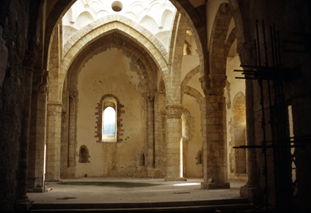
Figure 3. Church of Santa Maria della Valle (called Badiazza), central apse. Image courtesy of https://www.cistercensi.info/abbazie/abbazie.php?ab=1165 (accessed on 20 May 2021).
Of this mosaic, we only have a fragment of the face of Saint Peter (now in the Museo Regionale di Messina, inv. no. 967). Following some considerations by Demetrio Salazaro [36] (Volume 2, p. 68) and Ugo Monneret de Villard [37] (p. 72), in 1969 Ferdinando Bologna proposed dating this artefact to the beginning of 13th century and identified the subject as Frederick II of Swabia [38] (pp. 22–23). However, by mutual consent, art historians later allocated this fragment (now there is uncertainty as to the identity of the apostle) to the beginning of 14th century (about that, see [39] (pp. 2–3), [40] (p. 489), [41] (p. 9), [42] (p. 23)), thus following the testimony of Samperi. If it is plausible that the king represented in the apse of the Church of Santa Maria della Valle was Frederick III, it is also possible that he directly ordered its creation. Indeed, it seems that the Sicilian kings had an intense relationship with this monastery: First the Normans and then the Swabians granted it privileges and donations, and Peter III of Aragon was also particularly tied to it (about that, see [31] (pp. 1–42)). Bartolomeo di Neocastro says that this king visited the church on his way to Messina, immediately after the liberation of the city from the siege of Charles I of Anjou (1282) (“[Peter III of Aragon] jam ad limina Sacrae Domus Beatae Virginis de Scalis applicuit; lugubrem domum ingemmit, quam pudenter excoluit et hostis iniquitas laceravit” [43] (p. 42)).
The people of Messina attended and particularly venerated this church because there was a miraculous image of the Virgin (the depiction of the Madonna della Scala) (about that, see [35] (pp. 314–329)) on its main altar, and for this reason, it also received gifts from foreign princes and queens. In confirmation of the intense relationship between the monarchy and this church, in 1633 the abbess Livia De Gregorio established that every week a mass be celebrated for the dead and living kings of Sicily who, thanks to their donations, had contributed to its wealth (about that, see [31] (pp. 1–42). In light of the above, it is curious that in March 1285, the Dominicans Perrone of Aidone and Antonio of Monte Gargano, who had come to Messina to instigate a revolt against the Aragonese dominion, had their abode in the monastery of Santa Maria delle Scale (“Dicti vero Fratres Praedicatores, Messanam adeuntes, latentes morabantur in domo gloriosae Virginis Mariae de Scalis inter dominas moniales”) [43] (p. 78)).
A tradition has it that Frederick III was particularly bound to this monastery for sentimental reasons, because it was here that he met his future wife Eleanor of Anjou for the first time in May 1303, and thereafter, he came here often to restore his spirit, away from the whirlwind of political life (about that, see [34] (p. 253)). All of this seems rather improbable due to the fact that Santa Maria della Valle is in the hinterland and not that close to Messina, and contemporary sources recount that Eleanor arrived from the coast (about that, see [44] (pp. 458–459)). Nevertheless, the considerable restoration and remarkable reconstruction that the Aragonese king is thought to have ordered in 1303 make it highly possible that on this occasion, he wanted to portray himself acting as a donor in the apse of this church.
Having said this, we have to note that very little is known about the dimensions and visibility of this work of art, or the iconographic attention paid to rendering the royal image. From the report by Samperi, we only know that the king was depicted in the main apse of the church in an offering act but nothing more is said. However, the same Samperi wrote that in the main apse there was also a mosaic copy of the picture of the Madonna della Scala (probably made around 1221) (“Vi è in questo Tempio [namely, in the Church of Santa Maria della Valle] rimasta la copia di molto buona mano della Immagine di S. Maria della Scala, la quale stà in molta veneratione in quella contrada, e nella Tribuna maggiore, la quale era tutta artificiosamente lavorata di ricco Mosaico; vi era la Imagine di Nostra Signora adorata da due Cherubini, con alcuni caratteri greci intorno, le quali per essere logore dal tempo, non si possono perfettamente leggere; e essendo per l’humidità, e per la poco cura, caduta buona parte del Mosaico, solamente il volto della B. Vergine non hà macchia alcuna, e pare che fosse fatto di fresco, e che desse ancora spirito, e vita à quel luogo” [35] (p. 327). On the apse mosaics of this church, see also [31] (pp. 165–168)).
Considering the presence of the Virgin between two cherubs, we can assume that with respect to the Mother of God, the royal image was at a lower level of the apse and its size was not particularly monumental. For these reasons, it is probable that the image was not particularly visible from the naves of the church. Moreover, we have to consider that it was in the presbyterial area, therefore in a space generally divided from the naves by a more or less obscuring partition (a rood screen), to which the lay people generally had no access (even if some exceptions were possible). Consequently, said mosaic was in a place particularly connected to the sacred liturgy and, presumably, it performed a religious/devotional function in favor of the king’s soul and only the members of the ecclesiastical order could see it.
Architectural research has underlined that in the corners of the presbytery of the church there were four terraces, accessible from the outside and connected in pairs, which could be used as women’s galleries. The ones on the southern side could be arrived at from the monastery and they were reserved for the nuns, whereas the ones on the northern side were arrived at thanks to a terrace placed over the aisle and connected by a drawbridge to the bell tower (which was along the side of the building and separate from the main church) (about that, see [28] (pp. 5–6), [34] (p. 263)). These matronei would have been for the distinguished guests of the church who, in this way, could attend the religious services (about that, see [45]). Therefore, in this case, the mosaic could have been visible to the public but, all considered, limited to a small group of people (maybe the king with some kin, some closer members of the court, or some foreign ambassadors, local lords, or foreign princes visiting the monastery). Moreover, these terraces do not seem to have a particularly privileged view of the apse, and in reality, the royal image does not appear to have been designed to be clearly visible to those seated in these spaces.
5. The Mosaic of the Cathedral of Messina
Guidotto de Abbiate (and not de Tabiatis) (about that, see [46]), archbishop of Messina from 1304 to 1333, ordered a series of completions and improvements to the Cathedral of Santa Maria la Nuova in Messina: decoration of the main facade (left portal) and sacristy, encouragement for private citizens to build chapels and altars, erection of his funeral monument, and the construction, on the north side of the church, of new structures for the clergy (about the Cathedral of Messina, see [47], [30] (pp. 253–255), [48]). However, for our purposes, the most relevant endeavor is the decoration of the main apse with mosaics (Figure 4). It included a medallion with angels on the extrados, eight images of the Elders per side (Ap. 4:4), the Agnus Dei on the intrados in the middle, and the Etimasia and Christ enthroned and flanked by two seraphs, two angels, the Virgin, and Saint John the Baptist on the apse basin. Here, at the feet of Christ, small figures of Archbishop Guidotto, Frederick III of Aragon, and his son Peter II (identified respectively by the inscriptions GUIDOTUS ARCHEP[ISCOPU]S / FRIDERICVS REX / PETRVS REX) were depicted in the act of devotion (about this decoration, see [49] (Volume 2, p. 159), [47] (pp. 26–36), [50] (p. 319), [51], [48] (pp. 277–278), [52–56]). Later on, the side apses were also decorated with mosaics. The left (SS. Sacramento) has an image of the Virgin on the throne with the Child while the Hand of God (from the Heavens) is blessing her. Archangels Michel and Gabriel and saints Agatha and Lucy come up beside her while queens Eleanor of Anjou (wife of Frederick III as of 1302) and Elisabeth of Carinthia (wife of Peter II as of 1322) are at her feet. The right (S. Placido) has the image of Saint John the Evangelist. Saints Nicholas and Basil come up beside him while Louis of Aragon and John, Duke of Randazzo (regent of the Kingdom of Sicily from 1342 to 1348), are at his feet]. The king has a kneeling position, long hair, and shaved face and he wears a crown with pendilia, a loros, a red tunic, and a purple cloak with geometric decorations (maybe stylized stars). His iconography probably follows a Norman tradition (for more information and details about the iconographic tradition of the images of Frederick III, see [57]).
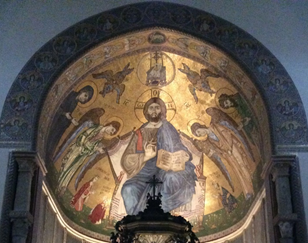
Figure 4. Cathedral of Messina, central apse with mosaic decoration rebuilt after the bombing on 13 June 1943. Photo taken by author.
Considering that Frederick III is also portrayed here as praying, historians think that the king played a preponderant role in the commission of this work. For this reason, we can consider this image in some sense to be an official representation of the sovereign (moreover, do not forget that Frederick III often resided in Messina and he made this city the de facto capital of his kingdom in place of Palermo [4] (pp. 88–89), [58]). Regarding the dating, we can assume that the work was finished by the death of Guidotto in 1333 and that its conception and creation began after 1321, when Frederick III admitted his son Peter II to the throne of Sicily (here he is being presented with the royal title) (for a summary of this event, see [6]). However, over the centuries, the Cathedral of Messina has suffered a lot of damage and its mosaic has undergone intense restoration, in some cases being remade from scratch (about that, see [51–56]). The earthquake on 28 December 1908 did not particularly harm the main apse but the fire provoked by the bombing on 13 June 1943 produced much more serious damage. Following the report written during the survey conducted after the collapse, the image of Frederick III was fortunately still “intatta” [53] (p. 602), however it was decided to completely rebuild all of the decoration of the apse. For this reason, what we can currently admire is the result of this remake (which, it seems, also covered the original remains).
Thanks to some drawings made during the surveys in 1908 and 1943 (about that, see [53] (figures 6 and 9)), historians have verified that the reconstruction fundamentally followed the general iconography of the original mosaics (about that, see [54] (pp. 80–81)). However, it must be pointed out that in reality, the image of Frederick III underwent some inexplicable changes (Figure 5). Indeed, it seems that originally, the king was not totally kneeling but rather in an erect position (albeit still in an attitude of reverence) and it is not clear whether he really wore a cloak. Moreover, he wore a crown that did not have the current odd shape but, on the contrary, was tall and square like the other diadems represented in the cathedral as well as in Norman iconography (about Norman iconography, see [59] (pp. 64–71)).
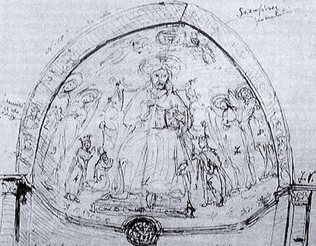
Figure 5. Graphic survey of the mosaics of the central apse of the Cathedral of Messina after the 1943 fire. Palermo, Biblioteca Comunale, Valenti Photographic Archives. Reproduced with permission of the Licensor. Detail of the image published in [53] (Figure 9).
This image of Frederick III is in the presbytery of the church and it is close to the main altar. Like the mosaic of the Church of Santa Maria della Valle, it was in an area that was only accessible to the religious and presumably separated from the naves by a rood screen. Therefore, the royal image was in a context particularly connected with the liturgy and, presumably, it performed a devotional function in favor of the king’s soul. In this connection, historians have noted that the whole iconographic program of the apse followed the typical pattern of the Byzantine Deesis and it was perfectly in line with both the funeral function of the place and the marked Marian connotation of the church and its ornamentation (on the main altar there was an icon of the Virgin Hodegetria that was worshipped like a relic, and the mosaic decoration most likely also had a scene of the Dormitio Virginis with the Assumption) (about that, see [56] (pp. 41–42)).
Certainly, lay people who went to the church could also see the royal portrait from the bottom of the nave because it was on the high level of the apse and it had rather monumental dimensions. However, its visibility was not particularly evident from this position, and it does not seem that this image was specifically conceived of for this type of solution. Indeed, it was best viewed from the presbyterial area, and as a matter of fact, if its beholders were lay people, in this case other parts of the church could have played a more functional role and provided a more important visual impact. For these reasons, it seems more probable that the royal image was addressed to the clergy of the cathedral as they officiated the services.
6. Conclusions
In order to summarize the general line of Frederick III of Aragon’s iconography, we can conclude that this king did not make an abundant use of his images. The mediums that he preferred to use were seals and coins, but he also adopted mosaics. The latter were placed in churches and, specifically, in the presbyterial area (with a particular predilection for the main apse), namely, in restricted areas. For this reason, although they had a monumental nature and a greater visual impact in comparison with seals and coins, presumably they were addressed only to religious beholders. Certainly, seals and coins had great circulation and could reach a wide part of population. However, their images were of small size, and the denaro especially did not pay accurate iconographic attention to rendering the details of the royal image. The iconographic themes adopted in these artefacts present Frederick III as a knight but also as a donor and devotee towards Christ or sacred figures (as Saint Peter). In the rendering of the royal image (and the related symbols of power, attire, and physical features), seals and coins seem to follow the Aragonese tradition of the brother James II. On the other hand, the mosaics probably adopted elements of the Norman iconographic tradition (see, for instance, the specific type of crown, the use of loros, and the embroideries of the robe).
